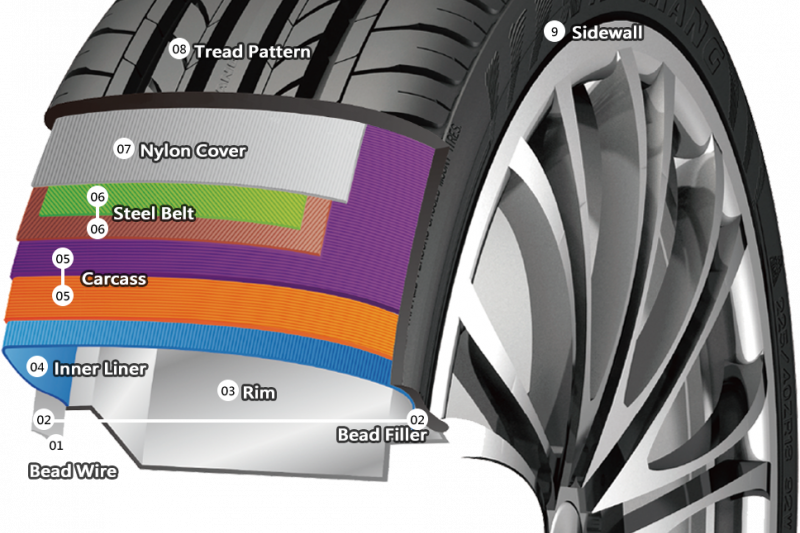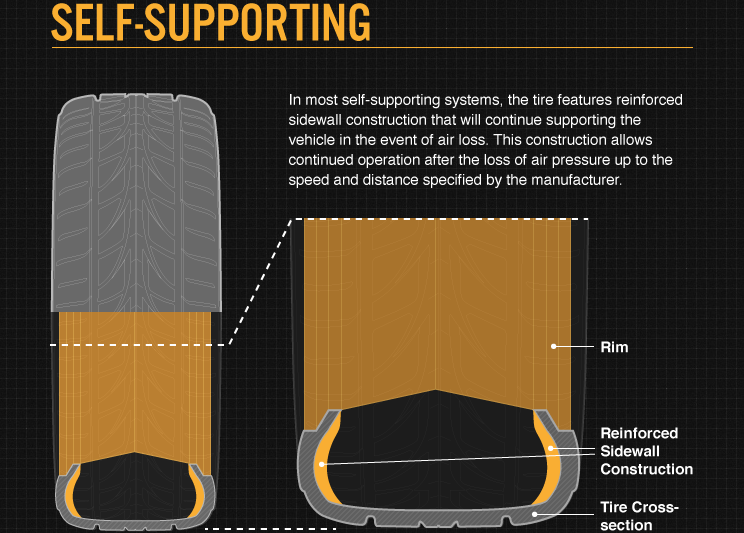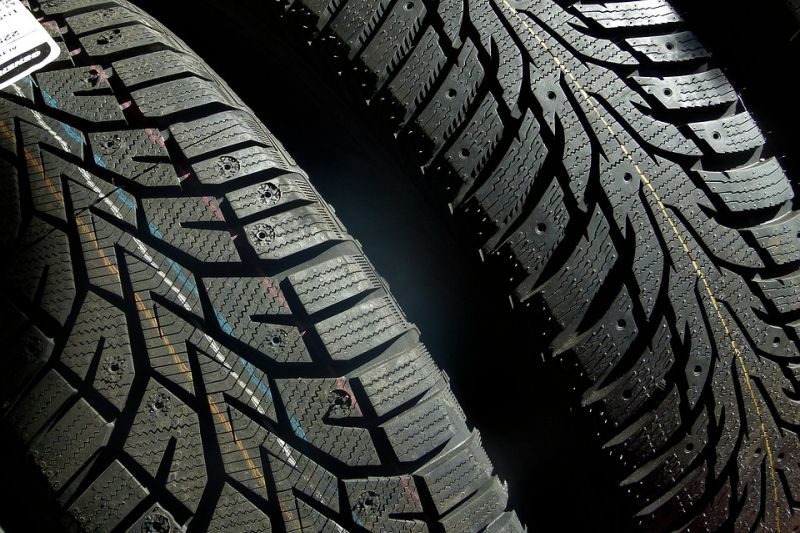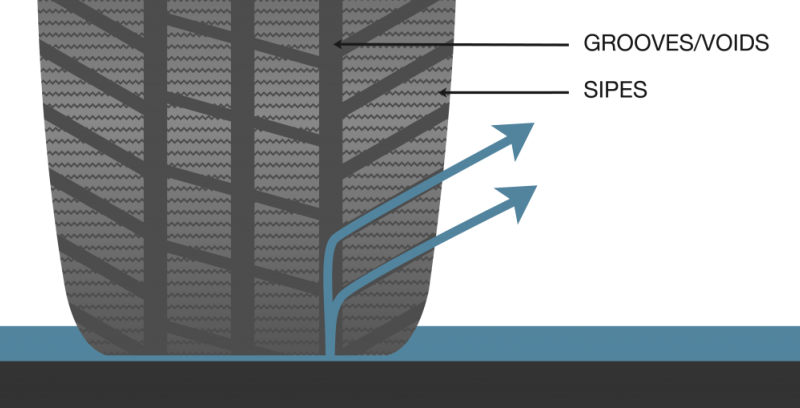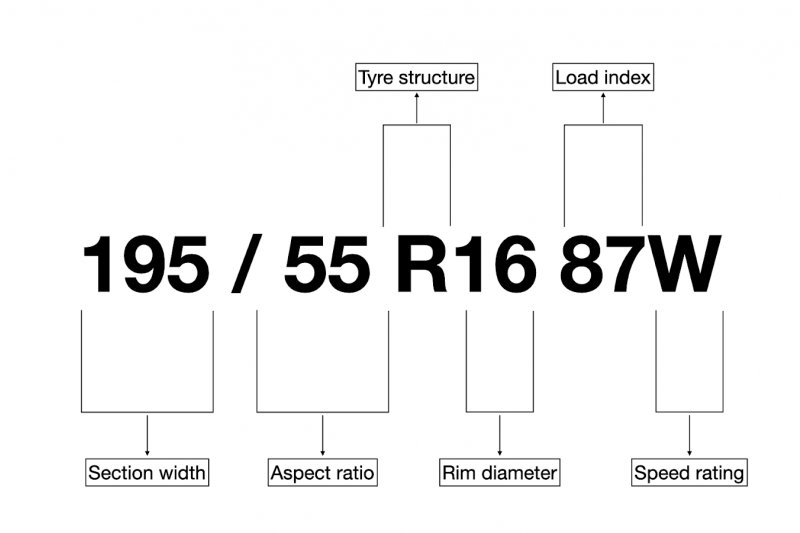“Four handprints” might be the theme of a Bridgestone ad, but there’s far more to the story behind tyres and how they grip the road.
At first glance, tyres might appear to be a simple technology made from a uniform piece of rubber that hasn’t significantly evolved over the last century.
In fact, they are made of multiple layers and incorporate numerous innovations and advances in material technologies to improve grip, durability and fuel economy.
Structure of a tyre
A tyre consists of a combination of metal, fabric and rubber parts.
The bead wire guides and holds the tyre onto the wheel rim, and provides strength to counter internal tyre pressure so that the tyre stays seated on the wheel when the vehicle is rolling.
The inner liner is also supported by the bead wire, and acts similarly to an inflatable rubber tube to seal air inside the tyre. When an air pump is used (e.g. at a service station) to inflate a tyre, it is the inner liner that expands to hold the air.
Other components of a tyre act to increase tyre strength, improve puncture resistance, and bind various parts of a tyre together.
The body ply consists of fabric sheets (known as plies), and is used to bond the inner liner with other parts of the tyre such as the sidewall and steel belt. A combination of polyester, nylon and rayon is typically used for the body ply, as these materials offer good resistance to heat and moisture as well as having a tendency not to shrink.
As its name suggests, the sidewall serves to further reinforce the side of the tyre, ensuring the body ply is protected and that the tyre can withstand lateral forces encountered at high speeds.
Steel belts are sandwiched between the body ply and tread block. Consisting of steel cords, they stabilise the tread block and maximise the tyre’s contact area with the road. They also work to improve the tyre’s puncture resistance.
The tread block forms the visible part of the tyre (alongside the sidewall), and directly grips the road to provide traction to the vehicle.
Run-flat tyres
Run-flat tyres are a special type of tyre that can continue to be driven in the event of a puncture.
If this happens, the driver can travel at slower speeds for a limited distance, typically around 80km.
These tyres are helpful as they allow the driver to find a safe location to change the tyre or to drive to the nearest service station, rather than having to immediately replace a flat tyre.
Run-flat tyres work through the use of a reinforced sidewall that can continue to support the vehicle despite the loss of air pressure.
What does tyre tread do?
Tyre tread is a term that refers to the intricate grooves and channels on the surface of a tyre. These grooves are moulded into the tyre as part of the curing process during manufacture.
The tread pattern used varies significantly depending on the purpose of the tyre (e.g. tyres for off-road use have a different pattern and tread depth to performance on-road tyres). However, the primary purpose of tyre tread remains the same – to dispel water and prevent the vehicle from aquaplaning.
Aquaplaning is the term used to describe a situation where the vehicle’s tyres act more like water skis.
Rather than displacing water and directly touching the road, a vehicle that is aquaplaning has tyres that skim the surface of the water. The tyres lose grip and skid, resulting in the driver completely losing control of the vehicle (including steering, braking and acceleration).
To prevent this, tread patterns provide channels for water to flow through while the rest of the tyre is able to continue to grip the road. In general, the deeper the channels, the greater the amount of water or other debris that can pass underneath without affecting tyre grip.
This is the key reason why tyres designed for off-road use typically have a very ‘knobbly’ tread pattern consisting of wide, deep grooves and blocks that maximise the flow of water and mud through the tyre.
Smaller channels, known as sipes, are placed at an angle to the main channels and work in concert to draw water away from the tyre.
Resist the roll: Silica to the rescue
More fuel-efficient vehicles sold today, such as hybrid and electric vehicles, are often sold with ‘low rolling resistance’ tyres. What exactly does this mean?
Rolling resistance is a measure of the energy consumed by a tyre as it travels a certain distance. As a flexible rubber tyre rotates and touches the road, the contact patch (the area of tyre contacting the road) deforms due to friction between the tyre and road surface, before rebounding to its original shape.
This friction, coupled with the rotation of the tyre, causes part of its movement (kinetic) energy to be converted and lost as heat (thermal) energy.
Although the contact patch rebounds to its original shape after touching the road, the heat energy loss from friction means that it never retains all of the kinetic energy it had.
This difference in movement energy before and after the tyre contacts the road, is known as the tyre’s hysteresis.
This principle can be compared to dropping a tennis ball and a bean bag (of the same size) from the same height. When dropped, the tennis ball will bounce much higher than the bean bag.
The tennis ball has a lower hysteresis than the bean bag, as the difference between its movement energy before and after bouncing is lower than the bean bag. The bean bag, therefore, has a comparatively high hysteresis.
From a tyre design perspective, the challenge hysteresis poses is finding the optimal compromise between efficiency and grip. An efficient tyre that preserves more of its kinetic energy will deform less in order to have a low hysteresis value, but in the process also have reduced grip.
In contrast, a tyre that can grip the road well will deform more to provide increased friction, but will be inefficient by having a comparatively high hysteresis value.
The introduction of silica into the tread compound has lessened the need to compromise between efficiency and grip. Silica is a material with unique properties relating to hysteresis. To take the analogy above, it combines the hysteresis properties of the bean bag at high speeds together with the hysteresis properties of the tennis ball at lower speeds.
When a car with silica in the tread compound is travelling at slower speeds, the tyre has a low hysteresis for greater efficiency. At higher speeds, the silica is able to have a high hysteresis and thereby offer increased grip as required by the driving conditions. This dual functionality alleviates the need to compromise between efficiency and grip.
Renault’s Zoe electric vehicle uses specially developed Michelin tyres incorporating silica into the tread to offer a low rolling resistance without affecting grip.
Tyre dimensions: breaking the code
All tyres have a set of markings to describe their size and performance capabilities. Tyres available from a service station or sold with a car come with markings in the following format:
The section width refers to the width of the tyre (in millimetres) from sidewall to sidewall. In the example above, the width of the tyre is 195 mm.
The aspect ratio (per cent) describes the height (thickness) of the tyre, from the bead to the top of the tread block, as a proportion of the tyre width. In the example above, the height of the tyre is 55 per cent of its width.
High-performance cars typically use thinner, “low-profile” tyres with aspect ratios below 35%, as these tyres offer greater lateral stability.
Ferrari’s new F8 Tributo, for example, uses tyres with a very low aspect ratio of 35 per cent at the front and 30 per cent at the rear.
The following letter refers to the tyre structure. Almost all cars today are sold with radial tyres, hence the “R” (as opposed to obsolete structures such as diagonal bias, “D”, or bias belted, “B”).
The rim diameter indicates the size of the wheel in inches. In the example above, the tyre is designed fit a wheel with a diameter of 16 inches.
The load index provides an indication of the heaviest load that the tyre can accommodate when travelling at its highest designed speed (as per the speed rating below). In the example above, a load index of 87 corresponds to the tyre being able to handle 545 kg at its maximum designed operating speed.
Displayed as a letter, the speed rating indicates the maximum speed that the tyre can travel at.
A “W” rating in the example above indicates that the tyre is designed to travel at a maximum speed of 270 km/h.

